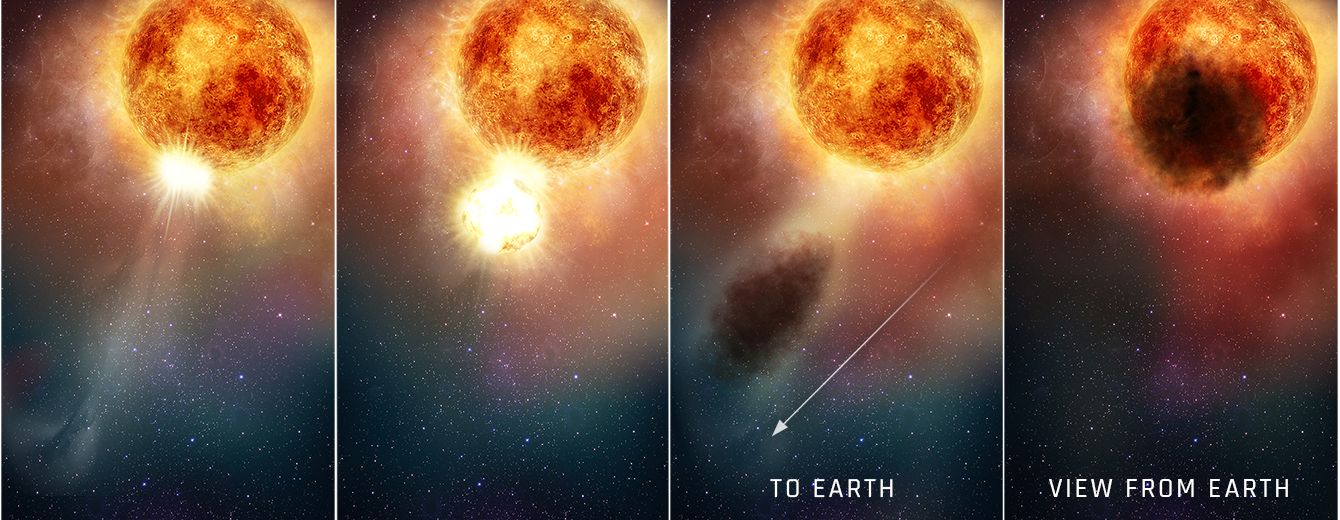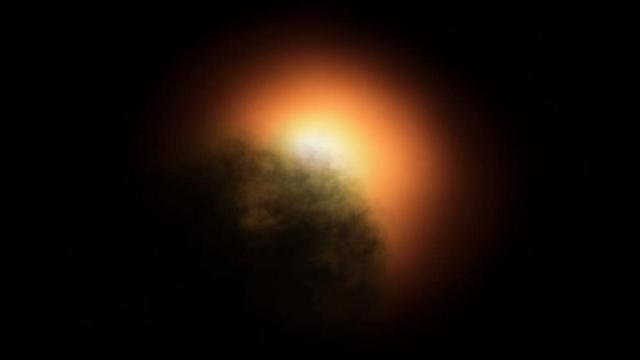Doomed supergiant star Betelgeuse has been acting strange lately, appearing far less bright than usual and then bouncing back to normal. Hubble Space Telescope observations from last year suggest the unexpected dimming was caused by a sudden ejection of hot gases, which formed an enormous dust cloud after cooling.
A new study set to be published in The Astrophysical Journal (preprint available here) offers an explanation for the anomalous darkening episodes seen on Betelgeuse: a gigantic dust cloud, which formed after hot, dense gases spewed out from the dying star. Viewed from Earth, this blanket of dust shielded the star’s surface, making it appear dimmer from our perspective, according to the research, led by Andrea Dupree from the Centre for Astrophysics at Harvard & Smithsonian.
A red supergiant star, Betelgeuse is nearing the end of its life. It’s poised to go supernova soon, by cosmological standards, though we can’t be certain as to exactly when. So bloated is this ageing star that its diameter now measures 1.234 million kilometers, which means that if you placed Betelgeuse at the centre of our solar system, it would extend all the way to Jupiter’s orbit.
Located around 725 light-years from Earth, Betelgeuse is among the brightest stars in the night sky, visible in the constellation Orion. You wouldn’t have known this, however, had you been gazing upon this supergiant back in February, when its brightness dropped to around 40 per cent of its normal luminosity.

“When the star became very faint in February 2020, this was the faintest that it had ever been since measurements began over 150 years ago,” explained Dupree in a Harvard & Smithsonian press release. “The dimming was obvious to everyone when looking at the constellation Orion; it was very weird, Betelgeuse was almost missing.”
As a semi-regular variable star, this sort of thing is expected, but not to such a dramatic degree. The dimming began in October 2019, reaching its peak in February of this year, and then returning back to normal by April. Brightness cycles on Betelgeuse are expected every 420 days or so, but the luminosity observed in February was at a historic low.
Explanations for the surprising drop in luminosity included copious amounts of dust in the vicinity of the star or a surface covered in gigantic splotches, similar to sunspots seen on our Sun.
Key to the new study were observations made by Hubble late last year, when the space telescope viewed the star in ultraviolet light. Data revealed hot, dense materials traversing through the star’s atmosphere from September to November, at speeds reaching 321,869 km per hour. As the new research shows, these two events — the big gaseous belch and unprecedented dimming — are likely connected.
“With Hubble, we had previously observed hot convection cells on the surface of Betelgeuse, and in the fall of 2019, we discovered a large amount of dense hot gas moving outwards through Betelgeuse’s extended atmosphere,” said Dupree in the press release. “We think this gas cooled down millions of miles outside the star to form the dust that blocked the southern part of the star imaged in January and February.”
To which she added: “The material was two to four times more luminous than the star’s normal brightness. And then, about a month later, the south part of Betelgeuse dimmed conspicuously as the star grew fainter. We think it possible that a dark cloud resulted from the outflow that Hubble detected. Only Hubble gives us this evidence that led up to the dimming.”
Thavisha Dharmawardena from the Max Planck Institute for Astronomy described the new work as interesting, but she said debate still remains about the role of dust in the dimming.
“Observatories that are most sensitive to dust have failed to find evidence for it, while Hubble doesn’t really provide any direct evidence for dust by itself,” explained Dharmawardena, who wasn’t involved in the new research, in an email. “It’s going to take some time to solve these outstanding issues, but one possibility to explain and tie all the data we have right now together is that the ejection of the dense gas from the hot part of the convective cell has left behind only the cool part and so has created a cool spot on the surface, which would then lead to the dimming. It looks like Betelgeuse is not ready to give up all of its secrets just yet, keeping astronomers on their toes.”
Future observations during a dimming episode would do much to bolster this interpretation of the data, but astronomers aren’t sure if this was a one-off event or the start of a new phase for the supergiant. Fascinatingly, this sudden dimming could be a signal that Betelgeuse is about to blow, though again, astronomers can’t be sure.
“No one knows how a star behaves in the weeks before it explodes, and there were some ominous predictions that Betelgeuse was ready to become a supernova,” said Dupree. “Chances are, however, that it will not explode during our lifetime, but who knows?”
